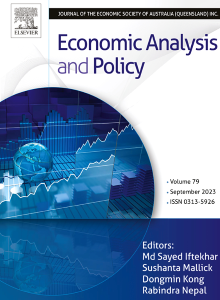The emerging driving force of green transformation in resource-based cities: Does the digital economy work?
IF 7.9
2区 经济学
Q1 ECONOMICS
引用次数: 0
Abstract
The green transformation is an investment by resource-based cities (RBCs) in their future development potential, with the rise of digital economy offering a new pathway to facilitate this investment. Based on panel data of 115 Chinese RBCs from 2011 to 2020, this paper quantifies green transformation efficiency (GTE) with a non-radial directional distance function (NDDF) and empirically examines the influence and mechanisms of the Big Data Comprehensive Pilot Areas (BDCPA) policy on the GTE of RBCs using a staggered difference-in-differences (DID) model. The results showed the following. (1) BDCPA significantly enhances the GTE of Chinese RBCs, confirming the vital role of digital economy in expediting their green transformation. (2) The impact of BDCPA on energy conservation and emissions reduction outweighs its influence on economic growth. Both growing and declining RBCs show a greater increase in GTE during BDCPA implementation. (3) Mechanism analysis indicates that BDCPA improves GTE primarily by promoting manufacturing upgrading, mitigating distortions in factor markets and improving the informatization level. Additionally, this paper employs social network analysis (SNA) to map the spatial correlation network of the digital economy. It unveils, for the first time, that RBCs positioned at the core of digital network have seen a more remarkable improvement effect of green transformation. This paper enriches the empirical evidence of how the digital economy empowers the green transition of RBCs and offers valuable insights for other developing countries seeking to utilize digital tools for achieving urban sustainability.
资源型城市绿色转型的新动能:数字经济管用吗?
绿色转型是资源型城市对未来发展潜力的投资,数字经济的兴起为这一投资提供了新的途径。基于2011 - 2020年中国115个红细胞的面板数据,采用非径向定向距离函数(NDDF)量化绿色转化效率(GTE),并采用交错差中差(DID)模型实证检验大数据综合试验区(BDCPA)政策对红细胞绿色转化效率的影响及其机制。结果表明:(1) BDCPA显著提升了中国红细胞的GTE,证实了数字经济在加速红细胞绿色转型中的重要作用。(2) BDCPA对节能减排的影响大于对经济增长的影响。在BDCPA实施期间,红细胞的增长和下降都显示出GTE的更大增长。(3)机制分析表明,BDCPA主要通过促进制造业升级、缓解要素市场扭曲和提高信息化水平来提升GTE。此外,本文还运用社会网络分析(SNA)绘制了数字经济的空间关联网络。它首次揭示了位于数字网络核心的红细胞绿色转型的改善效果更为显著。本文丰富了数字经济如何推动红细胞绿色转型的经验证据,并为其他寻求利用数字工具实现城市可持续发展的发展中国家提供了宝贵的见解。
本文章由计算机程序翻译,如有差异,请以英文原文为准。
求助全文
约1分钟内获得全文
求助全文
来源期刊

Economic Analysis and Policy
ECONOMICS-
CiteScore
9.80
自引率
9.20%
发文量
231
审稿时长
93 days
期刊介绍:
Economic Analysis and Policy (established 1970) publishes articles from all branches of economics with a particular focus on research, theoretical and applied, which has strong policy relevance. The journal also publishes survey articles and empirical replications on key policy issues. Authors are expected to highlight the main insights in a non-technical introduction and in the conclusion.
 求助内容:
求助内容: 应助结果提醒方式:
应助结果提醒方式:


